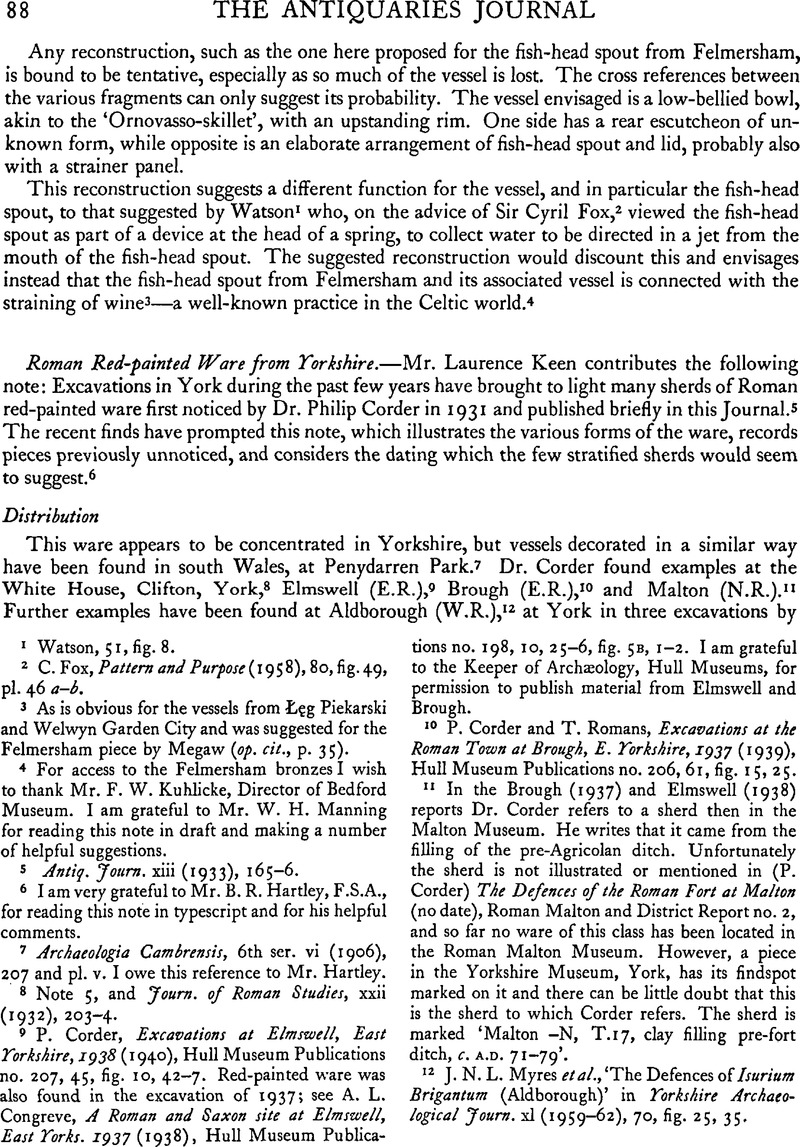No CrossRef data available.
Article contents
Roman Red-painted Ware from Yorkshire
Published online by Cambridge University Press: 29 November 2011
Abstract

- Type
- Notes
- Information
- Copyright
- Copyright © The Society of Antiquaries of London 1970
References
page 88 note 5 Antiq. Journ. xiii (1933), 165–6.Google Scholar
page 88 note 6 I am very grateful to Mr. B. R. Hartley, F.S.A., for reading this note in typescript and for his helpful comments.
page 88 note 7 Archaeologia Cambrensis, 6th ser. vi (1906), 207 and pl. v. I owe this reference to Mr. Hartley.Google Scholar
page 88 note 8 Note 5, and Journ. of Roman Studies, xxii (1932), 203–4.Google Scholar
page 88 note 9 Corder, P., Excavations at Elmswell, East Yorkshire, 1938 (1940)Google Scholar, Hull Museum Publications no. 207, 45, fig. 10, 42–7. Red-painted ware was also found in the excavation of 1937; see Congreve, A. L., A Roman and Saxon site at Elmswell, East Yorks. 1937 (1938), Hull Museum Publications no. 198, 10, 25–6, fig. 5B, 1–2. I am grateful Keeper of Archæology, Hull Museums, for permission to publish material from Elmswell and Brough.Google Scholar
page 88 note 10 Corder, P. and Romans, T., Excavations at the Roman Town at Brough, E. Yorkshire, 1937 (1939), Hull Museum Publications no. 206, 61, fig. 15, 25.Google Scholar
page 88 note 11 In the Brough (1937) and Elmswell (1938) reports Dr. Corder refers to a sherd then in the Malton Museum. He writes that it came from the filling of the pre-Agricolan ditch. Unfortunately the sherd is not illustrated or mentioned in (P. Corder) The Defences of the Roman Fort at Malton (no date), Roman Malton and District Report no. 2, and so far no ware of this class has been located in the Roman Malton Museum. However, a piece in the Yorkshire Museum, York, has its findspot marked on it and there can be little doubt that this is the sherd to which Corder refers. The sherd is marked ‘Malton -N, T.17, clay filling pre-fort ditch, c. A.D. 71–79’.
page 88 note 12 Myres, J. N. L.etal., ‘The Defences of Isurium Brigantum (Aldborough)’ in Yorkshire Archaeological Journ. xl (1959–1962), 70, fig. 25, 35.Google Scholar
page 89 note 1 I am grateful to Mr. Wenham for bringing these sherds to my notice and for allowing me to publish them in advance of his own reports.
page 89 note 2 Keen, Laurence, ‘Excavation at 52 Bootham, York, 1964’ in Yorkshire Archaeological Journ. xli (1963–1966), 360–3.Google Scholar
page 89 note 3 In an unpublished excavation by the Archaeological Society of Bootham School.
page 89 note 4 I am indebted to Mr. George Willmot, F.S.A., Keeper of the Yorkshire Museum, for facilities to study the pieces in his collections and for permission to publish them.
page 89 note 5 Since this note was submitted Mr. J. Radley, F.S.A., has kindly brought to my notice a further sherd in the Yorkshire Museum from the excavation of the Control Shelter, Old Station, York.
page 89 note 6 Corder, P., The Roman Pottery at Crambeck, Castle Howard (1928), Roman Malton and District Report no. 1, 30–2, 33, 35–7.Google Scholar
page 89 note 7 For a general survey of painted wares see Bettermann, K., ‘Die bemalte Keramik der frühen römischen Kaiserzeit im rheinischen Germanien’ in Saalburg jahrbuch, viii (1934), 97–129.Google Scholar
page 91 note 1 Brunsting, H., Het Grafveld onder Hees bij Nijmegen (Amsterdam, 1937), 84–7Google Scholar, pl. 3, 18–21, and Stuart, P.P.J., Gewoon aardewerk uit de Romeinse legerplaats en de bijbehorende grafvelden te Nijmegen (Leiden, 1963), 27–8, pl. 1, 23–5, pl. 2. 26–33.Google Scholar
page 91 note 2 Walke, N., Das römische Donaukastell Straubing-Sorviodurum (Berlin, 1965)Google Scholar, Limesforschungen Band 3, 42a. See also Koenen, K., Gefässkunde der vorrömischen, römischen und fränkischen Zeit in den Rheinlanden (Bonn, 1895), 79–80Google Scholar, Taf. XI, 6–9, and Gose, E., Gefässtypen der römischen Keramik im Rheinland (1950), 22, Taf. 18, 258–60.Google Scholar
page 91 note 3 See p. 88, n. 5.
page 91 note 4 See p. 89, n. 2.
page 91 note 5 Frere, S. S., Britannia, A History of Roman Britain (1967), pp. 98–100.Google Scholar
page 91 note 6 Royal Commission on Historical Monuments (England), Eburacum, Roman York (1962), 6a.
page 91 note 7 Simpson, G., ‘Cærleon and the Roman forts in Wales in the second century, Part 2’ in Archaeologia Cambrensis, cxii (1963), 46–9.Google Scholar
page 91 note 8 See p. 88, n. 12.
page 91 note 9 See p. 88, n. 10. I was unaware of further sherds from Brough now published in Wacher, J. S., Excavations at Brough-on-Humber 1958–1061, Reports of the Research Committee of the Society of Antiquaries of London, no. XXV (1969), fig. 62, 225 and 242, and fig. 78, 683.Google Scholar
page 91 note 10 See p. 88, n. 9.
page 92 note 1 See p. 88, n. 9.
page 92 note 2 See p. 88, n. 11.
page 92 note 3 See p. 89, n. 2.
page 92 note 4 See p. 89, n3.
page 92 note 5 See p. 88, n. 5.
page 92 note 6 The Department of Prehistoric and Romano-British Antiquities kindly gave permission for these pieces to be published.




